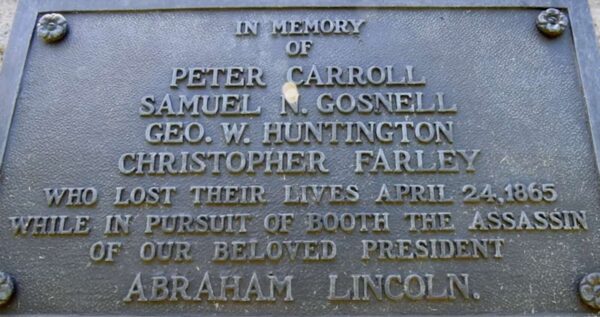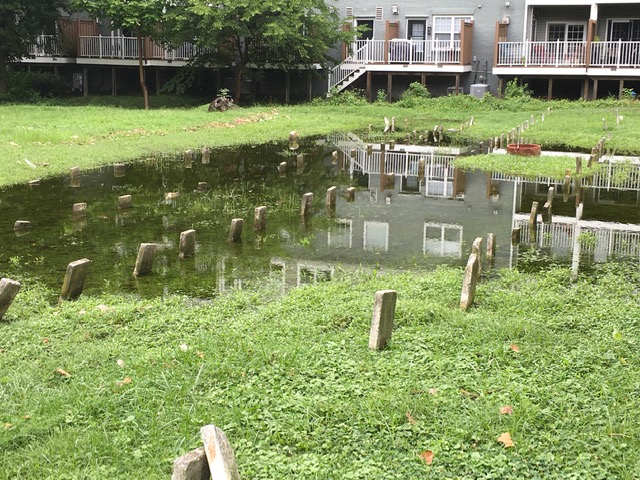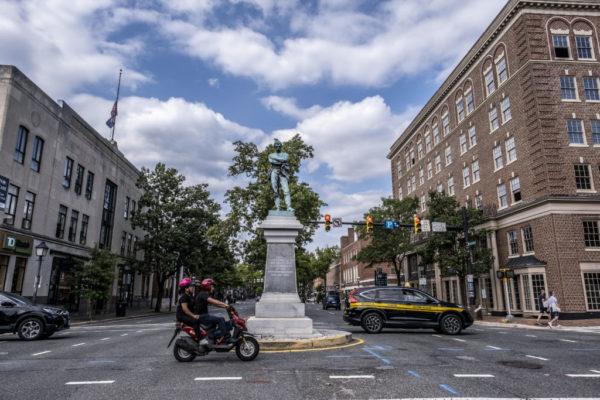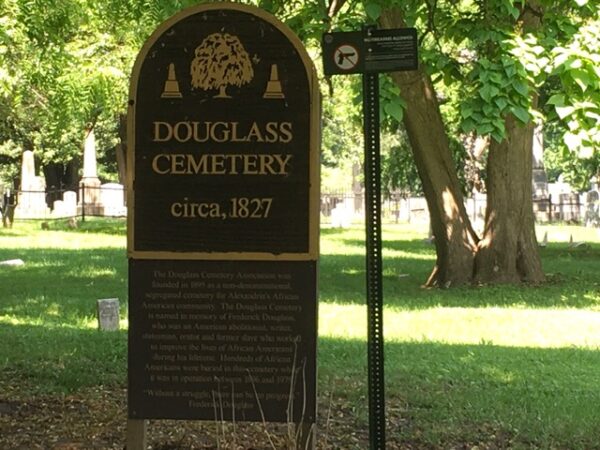
Fans of Apple’s new show Manhunt about the search for Abraham Lincoln’s assassin may be interested to learn that four Alexandria firemen who died during the 12-day search for John Wilkes Booth are buried in Alexandria National Cemetery.
The federal government initiated a massive search for Booth after Lincoln’s assassination on April 14, 1865. The search included usage of the Black Diamond, a ship made up of more than a dozen employees of the Alexandria Fire Department working with the Army Quartermaster Corps, according to the U.S. Department of Veterans Affairs.
The crew was tasked with patrolling the Potomac River in case Booth tried to slip across into Maryland.
Booth crossed the Potomac on April 22. Three days later, the Black Diamond crashed into the Massachusetts ferryboat, which was transporting approximately 400 former Union prisoners. The crash killed four members of the Black Diamond and 83 passengers of The Massachusetts.
Despite the war ending earlier that month, the four firemen — Peter Carroll, Christopher Farley, Samuel Gosnell and George Huntington were buried alongside Civil War casualties in Soldier’s Cemetery, now known as Alexandria National Cemetery (1450 Wilkes Street).
The federal government placed a granite boulder at the cemetery recognizing the firemen in the 1920s, and in the 1950s replaced their individual grave markers to have the same design as those of Union soldiers, according to the U.S. Department of Veterans Affairs.

Douglass Memorial Cemetery (1421 Wilkes Street) has long suffered flooding and neglect, but the City of Alexandria said plans to address issues at the cemetery will be presented at a meeting next week.
City employee Michael Johnson has been ringing alarm bells about the state of the cemetery for years. The cemetery has been a burial site for Black Alexandrians since 1827. Around 2,000 people were buried in the cemetery before burials stopped in 1974.
A city report said only 10% of the graves in the cemetery are well-defined, thanks in part to grave markers going missing and a lack of intact vaults and caskets.
The city sought funding earlier this year to support an oral history project related to the project.
The city said plans for the cemetery will be presented at the Nannie J. Lee Memorial Recreation Center (1108 Jefferson Street) from 6-7 p.m. on Tuesday, Dec. 5.
According to a release:
Douglass Cemetery, located at 1421 Wilkes Street, has several preservation issues, including flooding and drainage problems.
The City of Alexandria staff from the Office of Historic Alexandria, Department of Project Implementation, Transportation and Environmental Services, and Recreation, Parks & Cultural Activities are working to address these preservation issues. The Social Responsibility Group and the Friends of Douglass Cemetery have dedicated their efforts to raise awareness of the significance of the historic African American cemetery and resolve the preservation issues. The City has developed plans to implement solutions that are respectful and appropriate to the sensitive nature of the site. City Staff will present an update on the plans to address the causes of flooding and the anticipated timeline for the work.
The base of the Appomattox statue has resurfaced atop Confederate graves in Alexandria.
More than two years ago, the Appomattox statue was removed from Old Town by the United Daughters of the Confederacy (UDC). The base was moved into Bethel Cemetery last summer, while the statute itself reportedly remains in storage.
Bethel Cemetery owner James Clink wants the statute and base reunited atop the graves of 10 members of Col. John Singleton Mosby’s Rangers and 15 soldiers of the Confederate States of America (CSA) 17th Virginia Regiment from the Alexandria area.
Click has been working with the UDC to get the statue moved to the cemetery, and had the base of the statue moved in last summer. He has also installed a number of security cameras around the base.
“Personally, I’d like to see it up there myself,” Click told ALXnow. “It’s a piece of history. Right now it’s somewhere in a warehouse in storage. They won’t say where, just that it’s in a big crate.”
Appomattox was erected by the Robert E. Lee Camp at the intersection of Prince and S. Washington Streets in 1889 and depicted an unarmed CSA soldier facing south with his head bowed. The names of CSA soldiers from Alexandria who died in the Civil War are carved on the base of the statue.
Fruitless attempts were made to remove the statue over the years and multiple drivers crashed their cars into it. The statue was toppled once by a crash in 1988. After getting the go-ahead from then-Gov. Ralph Northam in 2020, UDC quietly removed the statue.
Mayor Justin Wilson says before it was removed, City Council wanted it to be relocated to either a cemetery or museum.
“We did say all along that we felt it belonged in a museum or graveyard,” Wilson said. “This sounds like an issue for the private property owner to work through.”

Neighbor Diane Devendorf lives near the cemeteries and finds the Appomattox statue and its base offensive.
“I think that it’s very disrespectful to place that statue there without any regard for the families that have loved ones surrounding the location,” Devendorf said. “There are traditional African American cemeteries right up the street and there is no way to get to them without passing what will be the Appomattox eyesore.”
Bethel Cemetery is part of the Wilkes Street Cemetery Complex, which is a collection of 13 cemeteries located near the Carlyle neighborhood. More than 35,000 people are buried in the cemeteries, including previously enslaved men and women, U.S. Colored Troops, thousands of Union troops and CSA troops. There are nearly 11,000 people buried at Bethel Cemetery, which was founded in 1885 and remains an active cemetery.
The cemeteries were founded in the early 19th century in response to a Yellow Fever epidemic that resulted in more than 300 deaths, according to David Heiby, who conducts tours at the sites and is the superintendent of the Presbyterian Cemetery.
The following lists the 13 established cemeteries in the area and the years they were founded:
- Penny Hill Municipal Cemetery (1796)
- Christ Church Cemetery (1808)
- Trinity Cemetery (1809)
- St. Paul’s Cemetery (1809)
- The Presbyterian Cemetery and Columbarium (1809)
- Alexandria National Cemetery (1862)
- Methodist Protestant Cemetery (1829)
- Home of Peace Cemetery (1857)
- Union Cemetery of the Washington Street Methodist Church (1860)
- Bethel Cemetery and Little Bethel Cemetery (1885)
- African American Heritage Park (1889)
- Douglas Memorial Cemetery (1895)
- Agudas Achim Cemetery (1933)

There are nearly 200 years worth of stories buried at 1421 Wilkes Street.
The site started being used as a burial place for Black Alexandrians in 1827, but was officially established as the Douglass Memorial Cemetery in 1895. The last burial was in 1975.
Now, the Office of Historic Alexandria is hoping for funding to help tell the stories of the dead in the cemetery and their families.
The city is seeking $20,000 in grant funding from Virginia Humanities to support oral history documentation.
“The Office of Historic Alexandria is initiating a project to research and preserve the history of Douglass Cemetery,” said a memo from Gretchen Bulova, director of the Office of Historic Alexandria. “A large component of this project is to facilitate oral history interviews with descendants of family members interred in the cemetery.”
The project will include training Howard University students as interviewers to assist with the oral history collection and create a documentary.
The cemetery has been through the wringer in recent years, plagued by floods that have washed away headstones and faced years of disrepair. In recent years, the city has started taking steps to better preserve the cemetery and prevent flooding problems at the site.
The grant for the oral history program is scheduled for review at the City Council meeting on Tuesday, Jan. 24.

